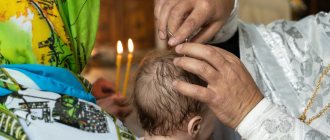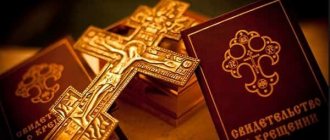Everyone, even a person far from religion, knows that the sign of the cross is not performed in exactly the same way in Orthodox and Catholic denominations. Believers who attend church services, of course, know that Orthodox Christians cross from right to left, and Catholics vice versa.
However, many believers have difficulty in how to correctly cross another person. Indeed, if you make the habitual movement of the sign of the cross over someone, and not over yourself, then the order of the shoulders will be disrupted. Is it important? And how to call a blessing on another person correctly, without violating the canons? Why do you need to be baptized? Such questions are relevant for many people who, for some reason, do not dare to ask them to the clergyman in the temple.
Why and how are they baptized? How to properly cross another person?
Everyone, even a person far from religion, knows that the sign of the cross is not performed in exactly the same way in Orthodox and Catholic denominations.
Believers who attend church services, of course, know that Orthodox Christians cross from right to left, and Catholics vice versa. However, many believers have difficulty in how to correctly cross another person. Indeed, if you make the habitual movement of the sign of the cross over someone, and not over yourself, then the order of the shoulders will be disrupted. Is it important? And how to call a blessing on another person correctly, without violating the canons? Why do you need to be baptized? Such questions are relevant for many people who, for some reason, do not dare to ask them to the clergyman in the temple.
What exceptions to the rules are there?
Every Orthodox Christian knows that baptism is a great religious sacrament that occurs only once during the life of a believer. Despite the fact that repeating the ritual is not stipulated by the Church, sometimes situations still arise that can be considered as exceptions to the rules.
The second baptism of a child can be carried out in the following cases:
- If the ceremony was performed not by a clergy person, but by another person who is not a clergyman. Such situations sometimes occur if a populated area is located at a great distance from an Orthodox church and it is not possible to get to it with a baby.
- If the ceremony is performed incorrectly. A new baptismal ritual may be required if the previous one was carried out with violations, unacceptable errors, and with the reading of prayer texts that did not correspond to the sacrament. In this case, all errors must be recorded and confirmed (preferably by several persons at once).
Sometimes an adult has reasonable doubts that he underwent baptism as an infant. This becomes a serious obstacle to the acquisition of true faith and the desire to live according to Christian commandments. In such situations, the Church allows for the possibility of conducting a new ritual with other godparents.
If you have a sincere desire to be re-baptized, you should contact a priest and tell him in detail about all the circumstances of making such a serious decision.
When is the sign of the cross performed?
This prayer movement is appropriate in any life situation. Intuitively, believers cross themselves when they are very frightened or when faced with something incomprehensible, when they receive any significant news or when they learn shocking information. They sign themselves with the sign of the cross in many other life situations.
But in addition to the circumstances when the prayer movement is performed on a whim, there are also those in which it is customary to make the sign of the cross for yourself or another person. Such situations include primarily:
Of course, it is necessary to overshadow another person with a sign both by giving a blessing and in many other circumstances. We must not forget about this action when starting any important activity or starting a new business.
If it is necessary to cross yourself near an icon, then this is done three times. Twice a person makes the sign of the cross, approaching the image and stopping in front of it. After this, he prays, sets a candle and places it on the frame of the icon. Then he crosses himself a third time, bows and moves away from the image.
Is it necessary to make the sign of the cross during temptations?
The Holy Fathers called for the sign of the cross to be applied when overcoming various passions. For example, blzh. Jerome of Stridon mentioned performing the sign of the cross during sadness and mourning for the deceased, and St. John Chrysostom taught: “Has anyone offended you? Mark your chest with the sign of the cross; remember everything that happened on the Cross - and everything will go out” (Conversation 87). However, most often the sign of the cross is mentioned, including the sign of the cross. Cyprian of Carthage (“Book of the Fallen”), as an invisible seal that drives away the devil. One of the sections of the “Apostolic Tradition” sschmch. Hippolyta of Rome reveals in detail precisely this aspect of the sign of the cross (“On the Sign of the Cross”). But most of all, the fight against demons with the help of the sign of the cross is spoken of in monastic writing. In the Life of St. Anthony the Great gives the following instruction: “Demons, he says, produce dreams to frighten the fearful. Therefore, seal yourself with the sign of the cross and go back boldly, but leave it to the demons to make a mockery of yourself” (“Teachings”). In the life of St. Gregory the Wonderworker, Bishop of Neocaesarea, tells how he, being forced to spend the night in a pagan temple, expelled all demons by drawing the sign of the cross in the air during ordinary evening prayers. Even non-believers resorted to using the sign of the cross against demons. Thus, Emperor Julian the Apostate, having already renounced his faith, once involuntarily crossed himself when he was frightened, writes St. Gregory the Theologian (“Word 4”).
How to overshadow another person with a sign?
How to properly cross another person? Orthodoxy gives an unambiguous answer to this question - the sign should lie as if the person had crossed himself.
Accordingly, an important point in this action is the order of alternating shoulders. This is where the difficulty for many people lies in how to correctly cross another person. For example, in a gesture of blessing, the hand, when moving from the stomach, should go not to the right, but to the left, since the person who is making the sign of the cross, as a rule, stands in front of the one who makes it.
When did they first begin to make the sign of the cross during worship?
In worship, at least since the 3rd century, the sign of the cross has been used both by clergy when performing the Sacraments, and by all the faithful at certain moments of the service. Origen already talks about the sign of the cross before beginning prayer and reading the Holy Scriptures (see Selecta in Ezechielem). In many traditions, there is the imposition of a “seal” on the forehead of catechumens in preparation for baptism or as a post-baptismal signatio on the newly baptized.
Are there differences in the sign overshadowing a person standing with his back and his face?
The only difference in making the sign of the cross over a person facing the person blessing and one who has his back turned is in the direction of movement of the hand.
How to cross another person correctly if he is facing? The relation of the figure of the one who is overshadowed by the sign to the face of the blessing takes the same position as the reflection in the mirror. Accordingly, the movement in the prayer gesture should be directed so that the first shoulder is the right one.
How to correctly cross another person if his back is standing? Just like yourself. Since the person being blessed is not opposite the one performing the sign, that is, does not take a mirror position, the direction of movement of the hand should be familiar. Of course, the brush needs to be turned towards the one who is making the sign of the cross.
Source
When should and should not the sign of the cross be performed at a worship service?
In the modern practice of the Russian Orthodox Church, the sign of the cross is necessarily performed when blessing with a sacred object - the Gospel, the Cross or the Chalice. It is also customary to make the sign of the cross when reading or singing “Come, let us worship”, the Trisagion, at the beginning and at the end of the reading of the Holy Scriptures, on “Alleluia”, when reading and singing the Creed, on dismissal. The custom of being baptized during each of the petitions of various litanies is not statutory (it does not occur in the Greek and Old Russian traditions). The sign of the cross is performed when passing through the temple opposite the Royal Doors. People make the sign of the cross when placing a candle on a candlestick in front of an icon, before applying it to an icon, before consuming prosphora. It is not necessary to be baptized during the bishop’s or priest’s greeting “Peace to all” or other exclamations accompanied by the blessing of the people with the hand. The sign of the cross is not performed during the reading or singing of psalms and stichera; it is forbidden to be baptized when approaching the Holy Chalice for Communion. The sign of the cross in certain cases is combined with bows, but they should not be performed simultaneously with the sign of the cross.
The meaning of the sign of the cross in Orthodoxy
The sign of the cross is an important and special sign in Orthodoxy, a symbol of faith in the Holy Trinity and a reminder of the sacrifice of Jesus Christ, crucified on the cross for the salvation of people. When applying the symbol, a person runs his hand from his forehead to the lower abdomen, then brings his hand to his right shoulder, then to his left. At the same time, the person being baptized has three fingers folded, symbolizing faith in the Holy Trinity: Father, Son and Holy Spirit.
By crossing oneself, a person inflicts divine protection on himself and expresses faith in God, his son Jesus Christ. The sign of the cross is applied slowly; parents often rebaptize young children themselves. After applying the sign of the cross, one should bow, so a person trusts in God’s mercy for his sinful existence.
In what situations is it appropriate to use it?
Man is a child of the Lord from birth. The divine essence is contained in the soul of every person. But this does not mean that it is necessary to be baptized all the time; applying the sign of the cross for no reason may look inappropriate. Situations when an Orthodox believer can make the sign of the cross:
Drawing the holy cross is a symbol of faith in the Lord. Believers should not be ashamed of rebaptism, because this holy action contains God’s grace and carries protection and a reminder of the Lord’s commandments. But at the same time, one should not allow oneself to be “ostentatious”, wave one’s arms violently and pray loudly. These actions are inappropriate; putting a cross on a person’s body is a spiritual sacrament that should not be rushed. The visible evidence of faith must be righteous and not harmful to a person’s soul.
How to be baptized correctly as an Orthodox Christian?
If a person’s soul is open to the Lord, then performing a religious action correctly will not be difficult for a believer. Features of applying the sign of the cross in the Orthodox tradition:
The application of the cross ends with a bow to the Lord, thus the person admits his sinfulness in relation to Heaven and asks for protection and God's blessing.
On a note. In the Catholic faith, the cross is applied from left to right, and the entire palm is used.
At the end of the ceremony, the bow is done up to the waist or all the way to the ground. When bowing to the ground, you must kneel; this is usually done within the walls of a temple or church. You can apply the Orthodox cross mentally, with an open heart and soul; the canons of the church do not prohibit this.
Do I need to make the sign of the cross if I suddenly find myself in a non-Orthodox church?
Church writers of the 4th – 5th centuries. They report that Christians are required to make the sign of the cross when forced to enter a pagan temple or synagogue. For example, St. John Chrysostom (“Against the Jews”) writes: “How will you enter the synagogue? If you seal your face [with the sign of the cross], all the enemy force that dwells in the synagogue will immediately flee; and if you don’t seal it, then at the very entrance you will throw away your weapon, and then the devil, finding you defenseless and unarmed, will cause you a lot of evil.” Particular attention was paid to applying the sign of the cross even when moving from one room to another inside a monastery or temple during the time of St. Columbanus of Luxea (VI – VII centuries) in the Irish monastic tradition, where penance was even provided for failure to apply the sign of the cross.
How to cross another person?
There is no greater protection for a child than the crosshairs from parents who pray for their children every day. Such a sign of God must be applied correctly. The cross on the body of the person being crossed should look as if he had crossed himself. That is, the movement of the hand in this case changes its direction, three fingers are placed first on the left side of the forearm, and then lead to the right. The person being baptized must stand face to face with the person making the sign of the cross.
Children are most susceptible to negative energy from outside, so it is recommended to carry out the baptism ceremony for a baby already on the fortieth day after birth.
If a child begins to experience prolonged periods of illness, screams and whims for no reason, insomnia, or, conversely, loss of strength, then the child needs help, because he does not yet know how to conduct religious rituals on his own. First of all, a frightened child must be calmed down and his face washed with holy water after reading a prayer. Then the sign of the cross is applied to the baby, so the child receives protection from demonic works and negative energy.
What does the rite of baptism mean?
Baptism means a particularly important sacred act, during which the Lord himself is invisibly present. At the same time, the most important events occur:
- a baptized person is cleansed from sin and joins his Creator;
- the new member of the Church receives the highest grace;
- a Christian goes through spiritual birth and renounces Satan forever.
If the baptismal ceremony is intended for a small child, all the necessary ritual actions are performed for him by the godparents (spiritual) parents. These people need to vouch for their child before God and take on serious responsibility for the spiritual upbringing of the godson throughout his life. The godmother and father should pray for him, accustom him to church sacraments, and set a personal example of what a true Christian should be. The priests claim that the prayers offered by the godparents for the young member of the Orthodox Church entrusted to them have special power and are capable of providing him with great help.
What else is important to know?
Let's consider cases when it is still appropriate and correct to use the sign of the cross:
The Orthodox cross is the main protection of people from sinful deeds and the works of the devil. Crucified on the cross, Jesus Christ atoned for human sins and took away from demons the opportunity to fully influence a person, protecting believers with them as a shield. Evil forces are afraid of the holy cross, which takes away their unclean power. Orthodox writings describe cases where poisoned food crossed with the holy cross lost its ability to harm the health of believers.
The tradition of drawing a cross has been known in Orthodoxy since time immemorial. Believers should not be embarrassed to apply the sign of the cross to themselves in society, but the church also allows the mental application of the cross to a person. After all, a person can express love and devotion to the Lord with his heart; it is important that at this blessed moment the person’s soul is open, and the person’s thoughts are honest and good.
The meaning of the Orthodox cross
The cross is the confession of faith of Orthodox Christians. It recalls the suffering of the Savior on the cross, which He endured to save sinners from hell and return to the Kingdom of Heaven. In general, death on the cross was considered the most terrible and shameful death. Men who committed a particularly serious crime indulged in it. On the cross, the hands and feet were nailed. Death occurred from suffocation, heart rupture and blood loss. They died on the cross painfully for long hours, and sometimes even days.
M. Gibson's film “The Passion of the Christ”
Christ chose the most painful death in order to take upon himself the sins of all mankind. Now sinners can repent to Him and receive forgiveness right there, thanks to such a terrible sacrifice of Christ. People do not fully realize the importance and greatness of the Savior’s feat for their sake. As well as the fact that the torment on the cross looked much more terrible than it is shown in icons, paintings and even Hollywood films.
Everyone knows M. Gibson's film "The Passion of the Christ" , which is simply impossible to watch due to the abundance of bloody scenes and torment. But even he could not convey the full horror of Christ’s suffering. On the cross the people were completely naked, and everyone was looking at them. Before this, Christ suffered severe beatings and scourging, so His body turned into a bloody mass. Then He carried the crossbar from the cross to Golgotha.
In order for the arms to stay on the crossbar, they were stretched, as a result, the joints of the arms were dislocated. In addition to the pain from the nails and dislocation, He experienced terrible suffocation and thirst. He had to constantly move to get air. He didn't hang motionless like in the movie. He was dehydrated, his pulse rose to 200, his blood pressure dropped to 70 over 40. Christ experienced vascular collapse and severe heart failure. He had severe convulsions. In addition, He experienced God-forsakenness; the Heavenly Father turned away from Him. This, perhaps, was the most terrible torment for Him.
Christ experienced all this in order to take upon Himself the sins of all mankind, so that we could enter the Kingdom of Heaven . In such suffering for people, one can see not only enormous patience, but unspeakable love. After all, He took all this upon Himself voluntarily!
That is why the cross as a symbol speaks volumes to believers. The Orthodox treat him very reverently. You cannot, for example, depict crosses on the floor, so as not to accidentally step on them. In every home, believers have a crucifix to which they bow and kiss.
Therefore, believers make the sign of the cross as often as possible as a sign of veneration for the Savior’s suffering on the cross. The Apostle Paul wrote: “for the Jews the cross is a temptation, for the Greeks it is foolishness, but for us it is God’s power and wisdom,” also: “I carry the deadness of the Lord in my body.”
How to baptize objects correctly?
How to baptize objects correctly?
When we baptize objects, we need to make the sign of the cross over them, pronouncing the same words as when applying the sign of the cross to ourselves. To depict a cross on any object, we first cross it upward with the words: “In the name of the Father,” then downward with the words “And the Son,” then to the left with the words “And of the Holy Spirit,” and then to the right with the words "Amen". You need to make the sign of the cross slowly and reverently with prayer to the Lord.
How to baptize people correctly?
In many Orthodox families, it is customary for the mother and father to bless their children with the sign of the cross before they leave the house. The child turns to face the mother or father, who baptizes them. First they touch their forehead, then their stomach, then their right shoulder and then their left shoulder. With such a blessing, parents pray that the Lord will protect their child and protect him with the power of the sign of the cross. The Cross of Christ and its image have unspeakable power; it has more than once delivered people from various troubles, sorrows and even death. Christians apply the sign of the cross to themselves, other people and surrounding objects. To know how to baptize people correctly, you just need to know how to be baptized yourself. In this text we use the word “baptize” in the meaning of “to make the sign of the cross.”
How to properly baptize food?
How to cross corners correctly?
Believers often make the sign of the cross not only themselves, but also everything that surrounds them. After the fall of the first people, evil forces became capable of harming people. Often we may not see evil spirits, and may not know why our troubles, temptations and bad mental states occur. The more often a person baptizes himself and everything that surrounds him with faith and prayer for God’s help, the easier it will be for him to walk along the road of salvation. How to cross corners correctly can be concluded from how to correctly apply the sign of the cross to other people and objects. You need to turn towards that corner and make the sign of the cross in front of you, first, in the air, make an image of the top of the cross, then the bottom, then the left side and finally, the right side. At the same time they say the words: “In the name of the Father and the Son and the Holy Spirit. Amen". The sign of the cross is always applied with the right hand; in addition to these words and applying the sign of the cross, you can read a prayer calling on the Power of the Cross of the Lord or other prayers. They ask the Lord to protect us with the Power of the Life-Giving Cross and protect us from all evil. You can read Psalm 90 or other Orthodox prayers according to your desire and the call of your heart. You can also pray in your own words, but be sure to wish spiritual salvation to all people. May the Lord make you wise and preserve you with the Power of His Life-Giving Cross.
Author of the article: Ksenia Orabey, theologian and religious scholar
Source
Sign of the Cross
The sign of the cross is the overshadowing of the sign of the Cross, externally expressed in such a movement of the hand that it reproduces the symbolic outline of the Cross on which the Lord Jesus Christ was crucified; at the same time, the one who overshadows expresses inner faith in the Holy Trinity; in Christ as the Son of God made man, the Redeemer of men; love and gratitude towards God, hope for His protection from the actions of fallen spirits, hope for salvation.
For the sign of the cross, we fold the fingers of our right hand like this: we put the first three fingers (thumb, index and middle) together with their ends straight, and bend the last two (ring and little fingers) to the palm...
The first three fingers folded together express our faith in God the Father, God the Son and God the Holy Spirit as the consubstantial and inseparable Trinity, and the two fingers bent to the palm mean that the Son of God upon His incarnation, being God, became man, that is, they mean His two natures are Divine and human.
You should make the sign of the cross slowly: place it on your forehead (1), on your stomach (2), on your right shoulder (3) and then on your left (4). By lowering your right hand you can make a bow or bow to the ground.
Making the sign of the cross, we touch our forehead with three fingers folded together - to sanctify our mind, to our stomach - to sanctify our inner feelings (heart), then to the right, then left shoulders - to sanctify our bodily strength.
About those who signify themselves with all five, or bow without having yet finished the cross, or wave their hand in the air or across their chest, St. John Chrysostom said: “The demons rejoice at that frantic waving.” On the contrary, the sign of the cross, performed correctly and slowly, with faith and reverence, frightens demons, calms sinful passions and attracts Divine grace.
Realizing our sinfulness and unworthiness before God, we, as a sign of our humility, accompany our prayer with bows. They are waist, when we bend down to the waist, and earthly, when, bowing and kneeling, we touch the ground with our heads.
“The custom of making the sign of the cross dates back to the times of the apostles” (Complete Orthodox Theological Encyclop. Dictionary, St. Petersburg. Published by P.P. Soykin, b.g., p. 1485). During Tertullian's time, the sign of the cross had already deeply entered the lives of Christians of his day. In the treatise “On the Warrior’s Crown” (about 211), he writes that we protect our forehead with the sign of the cross in all circumstances of life: entering and leaving the house, dressing, lighting lamps, going to bed, sitting down for any activity .
The sign of the cross is not just part of a religious ceremony. First of all, it is a great weapon. Patericon, paterikon and lives of saints contain many examples testifying to the real spiritual power that the image of the Cross .
Already the holy apostles, by the power of the sign of the cross, performed miracles. One day, the Apostle John the Theologian found a sick man lying by the road, suffering greatly from a fever, and healed him with the sign of the cross (Demetrius of Rostov, Saint. Life of the Holy Apostle and Evangelist John the Theologian. September 26).
St. Anthony the Great speaks about the power of the sign of the cross against demons: “Therefore, when demons come to you at night, want to announce the future, or say: “We are angels,” do not listen to them - because they lie. If they praise your asceticism and please you, do not listen to them and do not get close to them at all; it is better to seal yourself and your house with a cross and pray. Then you will see that they will become invisible, because they are fearful and especially fear the sign of the cross of the Lord. For, having taken away their strength with the cross, the Savior put them to shame” (The Life of our Venerable Father Anthony, described by Saint Athanasius in his letter to monks staying in foreign countries. 35).
“Lavsaik” tells how Abba Dorotheos, having made the sign of the cross, drank water taken from a well, at the bottom of which there was an asp: “Once Abba Dorotheos sent me, Palladius, at about nine o’clock to his well to fill a tub, from which all took water. It was already lunch time. Arriving at the well, I saw an asp at the bottom of it, and in fear, without drawing water, I ran screaming: “We are lost, Abba, I saw an asp at the bottom of the well.” He smiled modestly, because he was very attentive to me, and, shaking his head, said: “If the devil decided to throw asps or other poisonous reptiles into all the wells and springs, would you not drink at all?” Then, coming from his cell, he himself filled the tub and, having made the sign of the cross over it, was the first to immediately drink the water and said: “Where the cross is, there the malice of Satan can do nothing.”
The Venerable Benedict of Nursia (480–543), for his strict life, was elected in 510 as abbot of the cave monastery of Vicovaro. Saint Benedict ruled the monastery with zeal. Strictly observing the rules of fasting life, he did not allow anyone to live according to their own will, so the monks began to repent that they had chosen an abbot for themselves who did not at all suit their corrupt morals. Some decided to poison him. They mixed poison with wine and gave it to the abbot to drink during lunch. The saint made the sign of the cross over the cup, and the vessel, by the power of the holy cross, immediately broke, as if struck by a stone. Then the man of God knew that the cup was deadly, for it could not withstand the life-giving cross” (Demetrius of Rostov, Saint. Life of our Venerable Father Benedict. March 14).
Archpriest Vasily Shustin (1886–1968) recalls Elder Nektary of Optina: “Father tells me: “Shake out the samovar first, then pour water, but often they forget to pour water and start to light the samovar, and as a result, the samovar is ruined and they are left without tea. The water is standing there, in the corner, in a copper jug; take it and pour it.” I went up to the jug, and it was very large, two buckets deep, and massive in itself. I tried to move it, no, I didn’t have the strength, then I wanted to bring the samovar to it and pour water. Father noticed my intention and repeated to me again: “Take a jug and pour water into the samovar.” - “But, father, it’s too heavy for me, I can’t move it.” Then the priest approached the jug, crossed it and said: “Take it,” and I picked it up and looked at the priest in surprise: the jug felt completely light to me, as if it weighed nothing. I poured water into the samovar and put the jug back with an expression of surprise on my face. And the priest asks me: “Well, is it a heavy jug?” - “No, father. I’m surprised: it’s very light.” - “So take the lesson that any obedience that seems difficult to us, when performed, is very easy, because it is done as obedience.” But I was directly amazed: how he destroyed the force of gravity with one sign of the cross!” (See: Shustin Vasily, archpriest. Record of John of Kronstadt and the Optina elders. M., 1991).
At first, Christians crossed themselves with one finger, thereby emphasizing their faith in one God - as opposed to pagan polytheism. After the Ecumenical Council of Nicaea (325), which formulated the dogma of the unity of two natures in Christ, Christians began to cross themselves with two fingers. When Rus' was baptized into Orthodoxy, in Byzantium they were baptized with two more fingers, a custom that passed on to Rus'. Then, in the 11th century, in contrast to another heresy that denied the Trinity of God, it was prescribed to be baptized with three fingers (a symbol of the Trinity). But, due to the separation of Rus' from Byzantium, this custom was not introduced in Rus' until Nikon. The Old Believers, not knowing anything about the further development of church culture in Byzantium, stubbornly clung to two fingers. S.A. Levitsky











